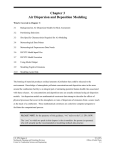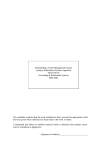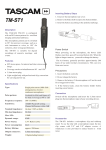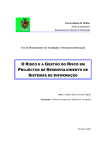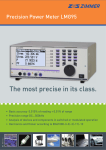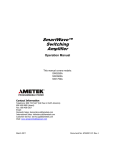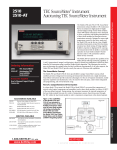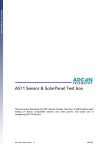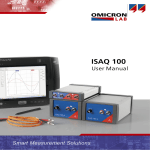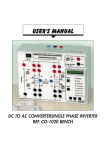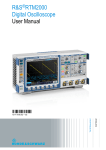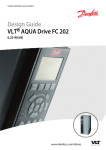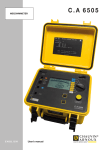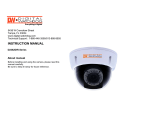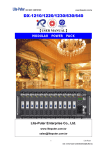Download App Note - Energy Saving Lamps V1
Transcript
ISAQ 100 - Application Note Load characteristics of energy saving lamps Page 1 of 27 Measuring the Load Characteristics of Energy Saving Lamps with the ISAQ 100 by Wolfgang Schenk © 2013 OMICRON Lab – V1.0 Visit www.omicron-lab.com for more information. Contact [email protected] for technical support. Smart Measurement Solutions ISAQ 100 - Application Note Load characteristics of energy saving lamps Page 2 of 27 Table of Contents 1 Executive Summary ....................................................................................................3 2 Technical Background ................................................................................................4 2.1 Classical light bulb or Edison Light bulb ..................................................................4 2.2 Energy saving lamps ...............................................................................................4 2.2.1 Neon tube bulb lamps (Gas discharge lamps) ...................................................4 2.2.2 LED-Array lamps (Light Emitting Diode) ............................................................5 2.3 Power factor Correction (PFC) ................................................................................6 3 Measurement Setup ....................................................................................................7 3.1 Measurement Setup ................................................................................................7 3.2 Anticipated Measurement Errors of the setup .........................................................9 3.3 Device Settings .....................................................................................................10 3.3.1 Set Probe Factor for CH1 and CH2 .................................................................10 3.3.2 Summary of Probe and Trigger Settings ..........................................................11 3.3.3 Setup Scope and FFT Mode ............................................................................11 3.3.4 Setup of Measurement in Scope View (time domain) ......................................12 3.3.5 Setup of Measurement in FFT View (frequency domain) .................................13 4 Measurement and achieved results .........................................................................14 4.1 Setup/Reference measurement.............................................................................14 4.2 Classical light bulb measurement ..........................................................................16 4.3 Energy saving lamp 1 (no PFC) ............................................................................17 4.4 Energy saving lamp 2 (with PFC) ..........................................................................18 4.5 LED array (no PFC)...............................................................................................19 4.6 Measurement Analysis ..........................................................................................20 5 Conclusion .................................................................................................................22 6 Appendix ....................................................................................................................23 6.1 Measurement- & Cursor- Settings .........................................................................23 6.1.1 Attaching of Cursor to the trace Plane/display .................................................23 6.2 Define Values for result display .............................................................................25 6.3 Getting measurement results to a test report ........................................................26 6.4 Device Configuration .............................................................................................27 Note: Basic procedures such as setting-up and adjusting the ISAQ 100 are described in the ISAQ 100 user manual. Note: All measurements in this application note have been performed with the ISAQ Measurement Suite V1.0. Use this version or a higher version to perform the measurements described in this application note. You can download the latest version at http://www.omicron-lab.com/isaq-100/downloads.html. Smart Measurement Solutions ISAQ 100 - Application Note Load characteristics of energy saving lamps Page 3 of 27 1 Executive Summary This application note explains how the ISAQ 100 can be used to measure the load behavior of modern lamps compared to a classical Edison light bulb. Therefore the voltages and the currents at different lamps are measured and compared in the time and frequency domain. The DUTs1 are: - A classical Edison light bulb - A modern energy saving lamp without PFC2 - An energy saving lamp withPFC2. - A LED array energy saving lamp In the first section some background information on the functionality of modern lamps in comparison to classical light bulbs is provided. The AppNote continues with a description of the measurement method, the setup of the ISAQ 100 and the measurement itself. In the last section the measurement results are analyzed and discussed. 1 2 DUT = device under test PFC = power factor correction Smart Measurement Solutions ISAQ 100 - Application Note Load characteristics of energy saving lamps Page 4 of 27 2 Technical Background This chapter describes the technique of light generation in the three different types of measured lamps. 2.1 Classical light bulb or Edison Light bulb Since December 31st, 1879 a development of Thomas Alva Edison is illuminating the whole world. Edison used an existing patent from the beginning of the 19th century and managed to improve the invention to make it a commercial success. The basic construction of the light bulb is a filament (glow wire) made of osmium and wolfram inside a glass flask commonly in the shape of a bulb. The flask is evacuated to nearly vacuum or filled with protective gas. The filament is connected to an electrical voltage and the current flowing through the filament heats it up to a high temperature till it glows. The luminous efficacy of a typical bulb ranges from 10–15 lm/W which means less than 5% of the energy used is converted into visible light. The typical live span of a classical bulb is about 1,000 hours.3 From its electrical structure a classical bulb appears as a resistive load. The classical light bulb used in this Application Note is a 230 V/25W bulb. From this value the following current and resistance can be derived: Equation 1 Equation 2 2.2 Energy saving lamps The following section will cover the most common types of energy saving lamps. The gas discharge lamp invented by Heinrich Geissler 1857, commercial introduced in 1907 by Daniel McFarlan Moore, a former employee of the Edison Lightning Company. And the LED4-lightning invented 1927 by Oleg Losev commercial introduced in 1962 by Nick Holonyak. 2.2.1 Neon tube bulb lamps (Gas discharge lamps) The basic construction of the gas discharge lamp is a glass tube filled with noble gas. Commonly Neon and Xenon are used. To reduce the energy losses and to increase the tube lifetime Mercury or Sodium vapors are added. In this App Note only low pressure discharge lamps are covered. 3 http://physicsed.buffalostate.edu/pubs/TPT/TPTDec99Filament.pdf, [Accessed 24.04.2013] 4 LED =Light Emitting Diode Smart Measurement Solutions ISAQ 100 - Application Note Load characteristics of energy saving lamps Page 5 of 27 To let the gas in the tube glow an electrical field between an anode and a cathode is created. The cathode made of a filament releases electrons to the tube, which are attracted by the electrical field between cathode and anode. On their way through the tube the electrons ionize the gas, switching back to their neutral state the atoms produce shortwave ultraviolet light. This ultraviolet light causes a phosphor coating on the inside of the tube to fluoresce, producing visible light. The luminous efficacy of a typical tube ranges from 100–200 lm/W which means more than 50% of the electrical energy used is converted into visible light. To create the electrical field a high DC-voltage is needed during ignition, which needs to be regulated during operation in order to not destroy the lamp. Connected directly to a constant-voltage power supply, a fluorescent lamp would rapidly self-destruct due to the uncontrolled current flow. To prevent this, fluorescent lamps must use an auxiliary device to regulate the current flow through the tube. From it structure the tube appears electrical as a nonlinear load. 2.2.2 LED-Array lamps (Light Emitting Diode) A light-emitting diode (LED) is a semiconductor light source. The LED has first been used as indicator lamp (1960) in many electronic devices and is now increasingly used also for other applications like for displays or lighting purposes. The basic structure of an LED is a combination of different donated semiconductor materials. A single crystalline substrate is doped with impurities to create a p-n junction5. The current flowing through the diode from the positive doped anode to the negative doped cathode emits photons, when electrons cross the p-n junction. The luminous efficacy of a LED ranges from 65–160 lm/W which means more than 50% of the electrical energy used is converted into visible light. In 2011, LEDs have become more efficient, so that a 6-watt LED can easily achieve the same luminous intensity, as a standard 40-watt Edison bulb. Typical lifetimes quoted are 25,000 to 100,000 hours, compared to 1000 hours of a light bulb. Heat and current settings can extend or shorten this time significantly. The most common symptom of LED failure is the gradual lowering of light output and loss of efficiency. LEDs have many advantages over incandescent light sources including lower energy consumption, longer lifetime, improved physical robustness, smaller size, and faster switching. Theoretically LED lamps could have any shape. To get the LED accepted by the customer it is often put in a package which looks like a classical bulb and contains an array of LEDs. As for neon bulbs an electronic control circuit is need to connect the array to the 230V AC-Network. This electronic control circuit is the reason that a LED-Lamp also appears electrical as a nonlinear load. 5 p-n junction = a junction built of positive and negative doped semiconductor material Smart Measurement Solutions ISAQ 100 - Application Note Load characteristics of energy saving lamps Page 6 of 27 2.3 Power factor Correction (PFC) The electronic control circuit of an energy saving lamp normally consists of a voltage converter and a power switch. The voltage converter shifts the phase and changes the amplitude of the current (see Figure 1 red curve). The power switch is periodical switched on or off. For instance the switch is off during 60% of a cycle and on the remaining 40% till the current reaches the zero crossing (see Figure 1 green curve). This is a simple technique which results in a phase shifted nonlinear current flow (see Figure 2). This power conversion is simple to generate, but results in reactive current and harmonic current which results in EMC noise. The power factor correction is a technique adapting the behavior of nonlinear load to the behavior of a resistive load. This means, that the shape of the device current is changed into a sine wave in phase with the applied voltage. (see Figure 3) As a result a nearly sinus shaped current flow like it would appear through a resistive load is achieved. This technique helps to reduce the emission of electromagnetic disturbances from the equipment.6 To create such a current Figure 1 - Signals creating nonlinear current shape shape a more complex electrical regulation is necessary. Figure 2 - Signal nonlinear current shape 6 Figure 3 - Corresponding linear load generated by PFC Source: http://en.wikipedia.org/wiki/Power_factor_correction#Power_factor_correction_in_nonlinear_loads Smart Measurement Solutions ISAQ 100 - Application Note Load characteristics of energy saving lamps Page 7 of 27 3 Measurement Setup In this section the measurement and device setup is described. Further on the dividing factors required to display the correct voltage and current are calculated. Additionally the anticipated measurement error of the setup is estimated. 3.1 Measurement Setup For all measurements in this AppNote we are using the ISAQ 100 and a measurement adapter which allows switching between three parallel bulb sockets. The adapter contains a measurement circuit to monitor the voltage and current of the actually operated lamp as shown in Figure 5 on page 8. The control unit of the ISAQ 100 is located on the left hand side of Figure 4. It gets the signals of CH1 and CH2 via optical fibers and is therefor 100% galvanically isolated from the “high voltage” area. In the middle the acquisition units and the measurement adapter with the different lamps are shown. They are located in the “high voltage” area The acquisition units are battery powered. In combination with the fibre optical links there is no direct electrical conection between the “high voltage” area and the control unit connected to measurement PC. Figure 4 - ISAQ 100 Measurement Setup with Light adapter on the right hand side Smart Measurement Solutions ISAQ 100 - Application Note Load characteristics of energy saving lamps Page 8 of 27 The circuit, to measure current and voltage consumed by the examined lamp is explained next. To measure current and voltage some measurement resistors are used. In addition three switches allow to individually switching on any of the three lamps. (see Figure 5) Figure 5 - Block diagram of the measurement setup R1 serves as a shunt, to measure the current flowing through the load and the measurement voltage divider (R2, R3). Since the value of R1 is 1Ω, the measured voltage is equals the current. The anticipated maximum voltage at CH1 is ± 325Vpeak. This exceeds the maximum input voltage of the ISAQ100 which is ± 250Vpeak. Therefore the voltage divider consisting of R2 and R3 is used to reduce the voltage connected to CH1. The following equitation shows how to calculate the factor to be set at the ISAQ100: 7 Equation 3 - Calculation of Probe Factor Equation 4 - Calculation of quiescent current The probe factor needed to adapt the voltage measurement at CH1 of the ISAQ100 is equal to 9.18 (see Equation 3). The probe factor need to adapt the current measurement at CH2 of the ISAQ100 is equal to 1. (The value of the shunt resistor R1 is 1Ω) 7 TRMS = true root mean square Smart Measurement Solutions ISAQ 100 - Application Note Load characteristics of energy saving lamps Page 9 of 27 3.2 Anticipated Measurement Errors of the setup Since the voltage divider is set in parallel with the load, there will be a quiescent current of 7.59 mA (see Equation 2). This quiescent current needs to be considered when we calculate the power drain by the different lamps. It does not alter the shape of the observed currents, since it appears as a resistive load. The voltage across the lamp is measured after the shunt. The voltage drop occurring at the shunt resistor does nearly not influence the voltage level at the lamps. The shunt R1 (1Ω) is more than 2000 times smaller than the impedance of the classical light bulb (2116 Ω. see section 2.1 ). This factor will result in an absolute measurement error8 of 0.15V at the maximum voltage of 325V. The voltage drop across the switches also can be neglected, since the resistance of the closed switch is in a range of 10 mΩ to 100 mΩ while the impedance of a classical light bulb is more than 20000 times higher (2116 Ω. see section 2.1 ). The classical light bulb has the smallest impedance of all used lamps therefore this statement is also valid for all other examined lamps. 8 325V/2116 = 0.15 V Smart Measurement Solutions ISAQ 100 - Application Note Load characteristics of energy saving lamps Page 10 of 27 3.3 Device Settings This chapter describes which settings are necessary to achieve accurate measurement results. 3.3.1 Set Probe Factor for CH1 and CH2 To ensure that the displayed voltage value corresponds with the voltage applied to the lamp under test the probe factor calculated in Equation 3 on page 8 is used. To set the probe factor follow this instructions: Click Configuration “Settings …” The menu is marked with the red eclipse (see Figure 6). Enter the calculated probe factor “9.18” into the textbox Probe Factor also marked (see Figure 7). Figure 6 - Settings The settings of device CH2 can be changed. In our case this is not necessary, since we use a shunt resistance of 1Ω (see Figure 5 on page 8) So we can keep the default probe factor of 1. Further settings are not required for this application. The device status and settings can be observed in the status bar located at the lower right edge of the ISAQ 100 display. (see Figure 8) Figure 7 - Set factor for voltage measurement Figure 8 - Status, configuration and setting of measurement overview Smart Measurement Solutions ISAQ 100 - Application Note Load characteristics of energy saving lamps Page 11 of 27 3.3.2 Summary of Probe and Trigger Settings This section gives an overview, how to do the settings of the two measurement modes. 3.3.3 Setup Scope and FFT Mode Scope Mode: FFT Mode: Time: Scale / div: 5ms Offset: 0s Frequency: Start: 0 Hz Stop: 500 Hz Center: 250 Hz Span: 500 Hz CH1: ACTIVATED Scale /div: 200 V Offset: 0V Coupling : DC CH1: NOT ACTIVATED CH2: ACTIVATED Scale /div: 200 mV Offset: 0V Coupling : DC Trigger: Source: Mode: Timeout: Level: Slope: CH2: ACTIVATED Y max: -10 dBV Y min: -110 dBV Y Scale / div: 10 dBV Format: dBV CH1 Auto 501 ms 126.3 mV raise (see Figure 9) Figure 9 - Scope View (see Figure 10) Figure 10 - FFT View Note for setting FFT-Mode: The voltage shape (CH1) is equal for all lamps. So CH1 is deactivated, to keep the focus on the differences caused by the different currents (CH2), the electrical characteristics of the DUTs. Note for Device Settings: The Device Settings are already made (see Section 3.3.1 ), but repeated here, to have an all in one summary on one page. Device Settings: CH1 Sample rate: 125 kSps Probe Factor: 9.18 x 1 Smart Measurement Solutions CH2: Sample rate: 125 kSps Probe Factor: 1 x ISAQ 100 - Application Note Load characteristics of energy saving lamps Page 12 of 27 3.3.4 Setup of Measurement in Scope View (time domain) To finish the setup of the scope view the result display will be set to: - UPeak : value of the peak voltage (peak max) (see Figure 11) - URMS : value of the RMS9 voltage - IPeak : value of the peak current (peak min) - IRMS : value of the RMS9 current (The value of the current is displayed in volt) Figure 11 - set measurement to Cursor 1 Value To attach a result display to a value displayed or calculated from the trace display, select the measurement from the result display (see Figure 11). As result the scope view should look similar to the picture below: Figure 12 - Result of the finished setup of Scope view with cursor and set measurement windows 9 RMS= Root Mean Square Smart Measurement Solutions ISAQ 100 - Application Note Load characteristics of energy saving lamps Page 13 of 27 3.3.5 Setup of Measurement in FFT View (frequency domain) To finish the setup of the FFT view three result display will be set to: - Cursor 1 Value : value of 50 Hz Frequency (fundamental wave) - Cursor 2 value : value of 150 Hz (third harmonic frequency) - Delta (C1-C2) : Difference between fundamental and third harmonic frequency To attach a result display to a value displayed or calculated at the trace display, select the measurement from the result display. (see Section 3.3.4 ) As result the FFT view should look similar to the picture below: Figure 13 - Result of the finished setup of FFT mode with cursor and set measurement windows Smart Measurement Solutions ISAQ 100 - Application Note Load characteristics of energy saving lamps Page 14 of 27 4 Measurement and achieved results The following chapter shows, how to perform the measurement and what results have been achieved. Once the setup is built up the measurement is quite simple. First perform a reference measurement without load. Then switch on the examined lamps one after another. Figure 16 - Simple energy saving lamp without PFC Figure 14 - Setup Reference measurement Figure 17 - Energy saving lamp with PFC Figure 15 - Test of Edison light bulb Figure 18 - LED-Array Energy Saving Lamp 4.1 Setup/Reference measurement From the setup we expect a quiescent current of about 7.59 mA. (see chapter 3.1 , Equation 4) The reference measurement meets the expected value with ITRMS = 7.75 mA or IPEAK = -10.88 mA pretty well. (see Figure 19, red trace) The exact values can be seen in the result displays. (not shown) Also the shape of the voltage and current traces are in phase and look like expected. We can observe a small disturbance at the voltage trace shortly after the peak values. This small disturbance will not influence the measurement a lot. It is related to the Power Grid and has the same shape for all lamps (see Figure 19, blue trace) Smart Measurement Solutions Figure 19 - Voltage and current of Setup/Reference measurement ISAQ 100 - Application Note Load characteristics of energy saving lamps Page 15 of 27 Figure 20 - FFT10 of Setup/Reference Measurement By analyzing the signal of the reference measurement in the frequency domain using the FFT10-Screen of the ISAQ 100 we get a feeling for the harmonics distributed by the setup with a small resistive load. The 50Hz base frequency has a value of -42.29 dBV the third harmonic at 150Hz shows a value of -96.21 dBV. Also the fifth (250 Hz), seventh (350 Hz) and ninth (450 Hz) harmonic can be observed (see Figure 20). For the comparison the different lamps these harmonics are not taken into account. All Values are displayed in dBV representing the current consumption of the used lamp in Ampere. This is because of the 1Ω shunt resistor. For instance -42.29 dBV is equal to a RMS value of 7.75 mA at the shunt11. 10 11 FFT: Fast Fourier Transformation 10^(-42.21dB/20)=0.007753A =7.75mA Smart Measurement Solutions ISAQ 100 - Application Note Load characteristics of energy saving lamps Page 16 of 27 4.2 Classical light bulb measurement As mentioned before, the Edison bulb behaves like a resistive load. Therefore, the current (red trace) follows the voltage (blue trace) in phase, but with different amplitude. (see Figure 21) The amplitude is defined by the resistance of the filament. This resistance can be calculated by the measured values reduced by the quiescent current. The calculated resistance of the filament meets with 2.1 kΩ exactly equals the expected value of 2.1kΩ. Also the electrical power consumption meets with 25.9 W pretty well the value of 25W indicated on the bulb. The values of all lamps will be compared in Table 1 on page 21. Figure 22 - Frequency spectrum of a classical light bulb Smart Measurement Solutions Figure 21 - Scope View of Edison Bulb ISAQ 100 - Application Note Load characteristics of energy saving lamps Page 17 of 27 4.3 Energy saving lamp 1 (no PFC) The current of the energy saving lamp with no PFC looks completely different compared to the Edison light bulb. The shape of the current looks like a cropped phase and is shifted by 4.2 ms which represents a phase shift of 75.6°. The pulse duty factor of the current is roughly 3.4 ms this equals about 33% time of one current period. (see Figure 23) The peak value of the current is with 304.8 mA nearly the doubled value of the current peak from the light bulb. The special shape of the current results in a worse spectrum of the current. With -22.89 dBV at the base frequency it is nearly 4 dB higher than for the light bulb. Also the attenuation of the third harmonic in relation to the fundamental is much lower, it is only 3.2 dB (see Figure 24). Smart Measurement Solutions Figure 23 - Scope View of energy saving lamp1 ISAQ 100 - Application Note Load characteristics of energy saving lamps Page 18 of 27 Figure 24 - Frequency Spectrum of energy saving lamp1 without PFC 4.4 Energy saving lamp 2 (with PFC) The current of the energy saving lamp with PFC looks more like a sine wave. The peak value of the current is 210 mA, which is about 25% higher than the current of the light bulb. The current is nearly in phase with the voltage. (see Figure 25) This current shape results in a much better spectrum of the current. The base frequency is 1.3 dB higher than the current through the light bulb. The attenuation of the third harmonic is with 16.2 dB much higher than the one measured for the energy saving lamp without PFC. The advantage of the PFC will result in less EMC problems. (see Figure 26) Smart Measurement Solutions Figure 25 - Energy saving lamp 2 with PFC ISAQ 100 - Application Note Load characteristics of energy saving lamps Page 19 of 27 Figure 26 - Frequency spectrum of energy saving lamp 2 with PFC 4.5 LED array (no PFC) The current of the LED array without PFC is quite equal to the energy saving lamp1. The main difference is the very low peak current. It shows approximately half the current consumption of the Edison bulb. The time delay is 4.25 ms which represents a phase shift of 76.5°. The pulse duty factor of the current with 1.4 ms respects about 14% on time of one period. (see Figure 27) The spectrum is equal to the spectrum of the energy saving lamp 1. The attenuation of the third harmonic compared to the fundamental wave is 7.85 dB, which is lower than for the Smart Measurement Solutions ISAQ 100 - Application Note Load characteristics of energy saving lamps Page 20 of 27 Edison bulb or the energy saving lamp 2. But no harmonic is bigger than -45dBV (see Figure 28). Figure 27 - Scope-Window of LED-Array source Figure 28 - Frequency spectrum of LED-array lamp without PFC 4.6 Measurement Analysis The achieved measurement results are summarized in this chapter showing some interesting results. Table 1 compares the following measured values of the lamps: Vrms: The root mean square voltage of the power grid Ipeak: The peak current drawn by the lamps Irms: The root mean square current drawn by the lamps P (el): The electrical power consumption of the lamps. Calculated from the root mean square values of the voltage and current. These values are compared to the datasheet values of the different lamps. The last two rows of the table are added to allow a better comparison of the used lamps: Smart Measurement Solutions ISAQ 100 - Application Note Load characteristics of energy saving lamps Page 21 of 27 Luminous efficacy: The amount of electrical energy converted to light. Efficacy: A factor showing how many bulbs can be replaced by the energy saving lamps. It is calculated from the luminous efficacy of an energy saving lamp divided through the luminous efficacy of the Edison bulb. Edison bulb Lamp 1 Lamp 2 LED Measurement values of the lamps Vrms [V] 233.8 V 234.1 V 234.0 V 234.0 V Ipeak[mA] 155mA 286mA 210mA 97mA Irms[mA] 111mA 95mA 131mA 12mA P(el)[W] 25.9 W 22.3 W 30.7 W 2.8 W Datasheet values of the lamps P(el)[W] 25 W 14 W12 30 W 4.4 W Irms [mA] 110 mA 100mA 130mA 18mA P(light) [Lm] 220 lm 810 lm 1900 lm 280 lm Luminous efficacy [Lm/W] 9 Lm/W 58 Lm/W 63 Lm/W 112 Lm/W Efficacy [bulb] 1.0 x bulb 6.6 x bulb 7.2 x bulb 12.7 x bulb Table 1 - Voltage and current reference measurement compensated The current consumption (Irms) of the energy saving lamp1 and the LED lamp are below the current consumption of the classical light bulb. By comparing the luminous efficacy it can be easily seen, that the efficacy of all energy saving lamps is at least 6 times better than for the Edison bulb. This means with the same amount of energy you need to light one room with an Edison bulb, you can light between 6 to 12 rooms, depending on which energy saving lamp you would use. By analyzing the FFT-results, we can observe potential EMC issues and observe the positive effect of the PFC. To provide a brief overview only the fundamental wave, the third harmonic and the difference between the both are shown: 50Hz [dBV] 150Hz[dBV] ∆[dB] reference -42,3 dBV -96,4 dBV 54,1 dB Bulb -18,6 dBV -54,0 dBV 35,4 dB Lamp1 -22,5 dBV -25,8 dBV 3,2 dB Lamp2 -17,3 dBV -33,5 dBV 16,2 dB LED -36,7 dBV -44,0 dBV 7,3 dB Table 2 - FFT- Influence of supply line in the frequency domain All Values are given in dBV with the 1Ω shunt the value of 0 dBV would represent 1A. Taking the reference as example, the fundamental current has a value of 8mA (-42.3 dBV) and the third harmonic has is equal to 15µA (-96.4 dBV).The reference values are measured, when only the measurement voltage divider (see Figure 5, page 8) is connected. This means all switches are off. When we compare the different lamps, we observe, that the Edison bulb has the biggest difference between fundamental wave and third harmonic. The PFC of the energy saving lamp 2 has the second best result. The difference at the LED Lamp is not big, but since the overall current consumption of the LED lamp is low (-36.7 dBV), the level of the third harmonic with -44 dBV does not influence the power grid too much. 12 Wrong marking of the lamp, datasheet has marked 100mA => Marking should be 24W Smart Measurement Solutions ISAQ 100 - Application Note Load characteristics of energy saving lamps Page 22 of 27 5 Conclusion The use of PFC (lamp 2) helps to avoid unwanted harmonics. This harmonics usually result in electromagnetic distortions. The PFC is especially essential for standard energy saving lamps, since the harmonics are higher than for an Edison bulb. For LED lamps the situation is better, due to the better luminous efficiency the over-all current is smaller and therefore the absolute value of the third harmonic is lower. Nevertheless, by using PFC also the EMC performance of LED lamps could be further improved. The ISAQ 100 can measure the terminal voltage and the shunt voltage at the same time without any restriction. Since the measurement is performed potential free, we do not need to take care about how the CH1 and CH2 are connected to prevent a short circuit caused by the common ground of a standard oscilloscope. Therefore the measurement can be performed with the highest standard of protection for the user. The fiber optic link also helps to measure in secure distance from hazardous or high voltage areas. This distance can be up to 3 km. The Scope View and FFT View of the ISAQ Measurement Suite provide an easy to use possibility to measure in time domain and frequency domain. The test results can easily be included in your test reports. The cursor and measurement options help to analyze and compare the results quickly. Smart Measurement Solutions ISAQ 100 - Application Note Load characteristics of energy saving lamps Page 23 of 27 6 Appendix All topics covered here are explained in the handbook in detail. Here they are customized to meet this particular application. 6.1 Measurement- & Cursor- Settings In this section we will learn, how to optimize the settings, such that the results can be analyzed and presented easily. - One will learn, how to get cursor into the diagram - Use the special features of the cursor - Attach the cursor either to CH1 or CH2 - Set the result display from the curve - Document the measurement to a test report Figure 29 - Configure Cursor 6.1.1 Attaching of Cursor to the trace Plane/display To attach a cursor to a measurement trace we right click next to the measurement trace or a double click into the measurement graph. The cursor will be attached to CH1 and a dialog will appear on the screen. (see Figure 29) Before the Cursors are set one can use the “Optimize” function. (see Figure 30) Now one period of both traces are inside the measurement display For Cursor 1 the feature “Jump to Max” (see Figure 30) can be used to move the cursor at the first peak of the sinus cycle. To attach Cursor 1 to CH2 one need to Figure 30 - Configure of cursor 1 select the menu “Configure…” (see Figure 30) The Menu Cursor 1 appears and one can attach the cursor to CH2. (see Figure 31) Once all settings are done one can finish by clicking on [OK]. The Cursor is colored like the respecting traces and appears at the upper edge of the trace display. (see Figure 32) Smart Measurement Solutions Figure 31 - Attaching Cursor 1 to Trace 2 ISAQ 100 - Application Note Load characteristics of energy saving lamps Page 24 of 27 Figure 32 - Trace plane/display with set cursor on Trace1 and Trace2 Using the feature “Jump to Min” results that the Cursor moves to the smallest value of the curve the cursor is attached to. (see Figure 33 and Figure 34) Figure 33 - feature Cursor 2 "Jump to Min" Smart Measurement Solutions Figure 34 - Cursor has moved to Min peak of CH2 ISAQ 100 - Application Note Load characteristics of energy saving lamps Page 25 of 27 6.2 Define Values for result display To finish the setup of the scope view the four result display will be set to: - UPeak : value of the peak Voltage (peak max) - URMS : value of the RMS13 voltage value - IPeak : value of the peak current (peak min) IRMS : value of the RMS13 current value (Remark: The current is displayed in volt) Figure 35 - set measurement to Cursor 1 Value To attach a measurement window to a value displayed or calculated at the trace display, one need to select the measurement from the measurement window (see Figure 35). As result of all settings the scope display should look like the picture below. (see Figure 36) Figure 36 - Result of the finished setup of Scope Plane/display with Cursor and set result display 13 RMS: rout mean square = Voltage of an corresponding DC-Voltage having the same effect like an AC-Voltage on a resistive load Smart Measurement Solutions ISAQ 100 - Application Note Load characteristics of energy saving lamps Page 26 of 27 6.3 Getting measurement results to a test report To document the measurements one need to get the measurement data from the ISAQ100 to a test report. In this chapter one can learn several ways how to export the data from the ISAQ100. Besides performing a screen shot there are several ways to copy measurement results to a test report. If one needs a picture or single measurement data, use a right click on the trace display, following options appear. (see Figure 37 and Figure 38) 1. “Save as Image…” 2. “Copy Chart to Clipboard” Figure 37 - Menu Cursor and copy 3. “Copy Settings to Clipboard” 1. Saving the chart as image one can choose between bmp-format and png-format 2. With choosing copy chart to clipboard, one can insert the chart direct into a test report. 3. Copy Settings to Clipboard means, all displayed numbers, settings, cursor values and values from the result display are copied as text and can be directly used for data analyzes. Figure 38 - "Copy Chart to Clipboard" option by right click on the measurement plane If one need to process the data afterwards, one can use the CSV Export from the Menu “File” (see Figure 39) [File CSV Export] The arising file can be analyzed using any spreadsheet-tool. Smart Measurement Solutions Figure 39 - "CSV Export" copies all measurement data as CSV-File and the data can be processed using EXCEL or any other spread sheet tool ISAQ 100 - Application Note Load characteristics of energy saving lamps Page 27 of 27 6.4 Device Configuration As a first step in the device configuration can be checked in the device setup. To display this setup click Configuration Device, the configuration looks like as shown below. On the picture following can be seen: (see Figure 40) - both channels work properly (acquisition unit ch1 and ch2 are displayed) - CH1 has the serial number 018 the scaling is 256V and the maximum amplitude is below 50% (green circles) (see Figure 41 left hand side) - CH2 has the serial number 011 the scaling is 0.64V and the maximum amplitude is above 50% (see Figure 41 right hand side) Figure 40 - Device Configuration, to check if setup works properly With checking the device configuration one knows that the data acquisition works properly. Smart Measurement Solutions Figure 41 - Setup shown in the GUI




























